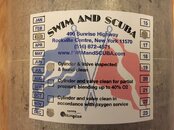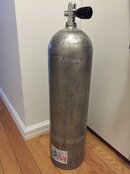It is probably criminal to sell that tank on CL to a buyer who has no idea that it is made of a dangerous alloy.
- Home
- Forums
- ScubaBoard Marketplace
- ScubaBoard's Classified Section
- Classifieds: Tanks, Valves & Bands
You are using an out of date browser. It may not display this or other websites correctly.
You should upgrade or use an alternative browser.
You should upgrade or use an alternative browser.
For Sale Aluminum 80cf Scuba Tank – New Hydro - $120 Obo
- Thread starter relax31
- Start date
Please register or login
Welcome to ScubaBoard, the world's largest scuba diving community. Registration is not required to read the forums, but we encourage you to join. Joining has its benefits and enables you to participate in the discussions.
Benefits of registering include
- Ability to post and comment on topics and discussions.
- A Free photo gallery to share your dive photos with the world.
- You can make this box go away
Proven safe. My usual shop wasn't able to confirm if the hydro testers gave it an eddy current / visual plus test or not, so I found another shop that had a visual plus tester, and had it tested yesterday. It passed, as anticipated.
There's lots of good, definitive information about 6351 tanks on Luxfer's site (see sampling of links below). Bottom line, it's not "dangerous", sustained load cracking is extremely rare and injuries are rarer still (2 cases out of the ~1.1mm 6351 tanks Luxfer made, both of which occurred before the visual plus test was invented), but it does require vis+ testing in between hydros, which is a good idea for all tanks. Yesterday, the tester told me that he has seen many, many newer alloy 6061 tanks fail the vis+ test due to cracks in the threads (despite passing a basic visual, and hydro). Supports my view that there's really not that much difference between my 6351 tank and 6061 tanks...
How many aluminum cylinders have exhibited SLC?
Are SLC-related scuba tank ruptures widespread?
How often should my Luxfer 6351-alloy scuba tank be inspected?
Why is it necessary to have my 6351-alloy cylinder inspected with an eddy-current device?
There's lots of good, definitive information about 6351 tanks on Luxfer's site (see sampling of links below). Bottom line, it's not "dangerous", sustained load cracking is extremely rare and injuries are rarer still (2 cases out of the ~1.1mm 6351 tanks Luxfer made, both of which occurred before the visual plus test was invented), but it does require vis+ testing in between hydros, which is a good idea for all tanks. Yesterday, the tester told me that he has seen many, many newer alloy 6061 tanks fail the vis+ test due to cracks in the threads (despite passing a basic visual, and hydro). Supports my view that there's really not that much difference between my 6351 tank and 6061 tanks...
How many aluminum cylinders have exhibited SLC?
Are SLC-related scuba tank ruptures widespread?
How often should my Luxfer 6351-alloy scuba tank be inspected?
Why is it necessary to have my 6351-alloy cylinder inspected with an eddy-current device?
Attachments
Proven safe. My usual shop wasn't able to confirm if the hydro testers gave it an eddy current / visual plus test or not, so I found another shop that had a visual plus tester, and had it tested yesterday. It passed, as anticipated.
There's lots of good, definitive information about 6351 tanks on Luxfer's site (see sampling of links below). Bottom line, it's not "dangerous", sustained load cracking is extremely rare and injuries are rarer still (2 cases out of the ~1.1mm 6351 tanks Luxfer made, both of which occurred before the visual plus test was invented), but it does require vis+ testing in between hydros, which is a good idea for all tanks. Yesterday, the tester told me that he has seen many, many newer alloy 6061 tanks fail the vis+ test due to cracks in the threads (despite passing a basic visual, and hydro). Supports my view that there's really not that much difference between my 6351 tank and 6061 tanks...
How many aluminum cylinders have exhibited SLC?
Are SLC-related scuba tank ruptures widespread?
How often should my Luxfer 6351-alloy scuba tank be inspected?
Why is it necessary to have my 6351-alloy cylinder inspected with an eddy-current device?
My shop will not fill 6351 alloy tanks. If PROPERLY tested they are safe. It is not a matter of whether the tank is safe or not but whether it has been properly tested. When I read statements like "ALL tanks should be visual plus tested" it makes me wonder if the shop which tested your tank knows what it is doing. Are they using Visual Plus III? Or are they using Visual Test, Visual Plus II or Visual Eddy? It is a known fact that anything other than Visual Plus III to inspect 6061 tanks will result in false results. Luxfer was recommending 6351 tanks need an eddy current test annually but you should NEVER eddy current test a 6061 tank.
On the Luxfer links you provided:
Contradicts the recommendation you should always test 6061 tanks.Only Luxfer’s proprietary 6061 aluminum alloy—which is not susceptible to sustained-load cracking—was used for Luxfer Australia cylinders.
It is possible the shop you are using is, falsely, finding SLC in 6061 tanks and scrapping perfectly good tanks.
P.S. if the shop is finding "many, many newer alloy 6061 tanks fail thes vis+ test" it leads me to believe they are not using Visual Plus III. No one else is finding "many, many" failures. If this was the case Luxfer would be recommending everyone use Visual Plus III to test 6061 clyinders.
Last edited:
The shop used a Visual Plus 3. They also had an Optical Plus, but did not need to use it on my tank as there were no suspicious signals that warranted further visual investigation. The technician allowed me to watch the whole time the tank was inspected & tested, and - while I'm not trained on these devices - he appeared to really know what he was doing. He had several years of experience, and was also very courteous and professional. He also had both 6351 and 6061 tanks in his workshop along with a document about testing 6351 tanks, and he definitely knew the difference - which is why I started asking him questions about his equipment and experiences with the different alloys, out of my curiosity.
Regarding testing 6061 tanks, I'm just passing along what he told me, and likewise it struck me as a very interesting comment. I am assuming the tanks he failed must not have failed due to SLC (agree; everything I've recently read on the topic says 6061 is not susceptible), but rather due to some other damage/cracking to the threads that was not readily apparent from a visual alone.
So... PROPERLY tested, and proven safe
Regarding testing 6061 tanks, I'm just passing along what he told me, and likewise it struck me as a very interesting comment. I am assuming the tanks he failed must not have failed due to SLC (agree; everything I've recently read on the topic says 6061 is not susceptible), but rather due to some other damage/cracking to the threads that was not readily apparent from a visual alone.
So... PROPERLY tested, and proven safe
I'm still skeptical. Anyone can talk knowledgeably to someone who does not know any better. This just tells me the technician talks confidently. It does not convince me that what he told you was true.
There is still the unanswered question. Due to SLC disasters Luxfer started recommending all 6351 alloy cylinders should be eddy current tested for SLC. If there was a problem with Luxfer 6061 alloy cylinders, why hasn't Luxfer put out a recommendation that all 6061 alloy cylinders should be Visual Plus III tested?
The shop you used claimed to have found "many, many newer alloy 6061 tanks fail the vis+ test". The shop I work at has a few dozen 6061 alloy cylinders. They have been in service for years. There are a few dozen shops in the province. They all have a few dozen 6061 alloy cylinders. None of these shops will touch 6351 alloy cylinders because they don't eddy current test. If many, many cylinders are failing, why have I never heard of one single incident?
From PSI (Professional Scuba Inspectors) regarding 6061 alloy tanks:
There is still the unanswered question. Due to SLC disasters Luxfer started recommending all 6351 alloy cylinders should be eddy current tested for SLC. If there was a problem with Luxfer 6061 alloy cylinders, why hasn't Luxfer put out a recommendation that all 6061 alloy cylinders should be Visual Plus III tested?
The shop you used claimed to have found "many, many newer alloy 6061 tanks fail the vis+ test". The shop I work at has a few dozen 6061 alloy cylinders. They have been in service for years. There are a few dozen shops in the province. They all have a few dozen 6061 alloy cylinders. None of these shops will touch 6351 alloy cylinders because they don't eddy current test. If many, many cylinders are failing, why have I never heard of one single incident?
From PSI (Professional Scuba Inspectors) regarding 6061 alloy tanks:
Evidence indicated that SLC develops slowly over a multi-year period. For example, detailed metallurgical examination of one ruptured SCUBA cylinder showed that the crack had been growing for eight years or more and would have been visible for about six years to a trained inspector using the proper crack-assessment protocol. Had that cylinder been carefully inspected, it could have been removed from service long before the rupture occurred.
teknitroxdiver
Contributor
It doesn't matter if it's properly tested or not. The majority of shops will not fill it, period.
StefinSB
Contributor
A <10 year Alu 80 sells for $50-100 in my neck of the woods depending on condition.
Similar threads
- Replies
- 1
- Views
- 368
- Replies
- 1
- Views
- 373
- Replies
- 3
- Views
- 596
- Replies
- 0
- Views
- 946
- Replies
- 24
- Views
- 2,961
- Home
- Forums
- ScubaBoard Marketplace
- ScubaBoard's Classified Section
- Classifieds: Tanks, Valves & Bands





